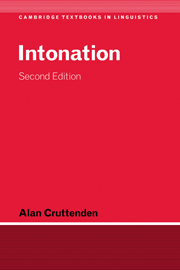1 - PRELIMINARIES
Published online by Cambridge University Press: 05 June 2012
Summary
Prosodic features
Phonetics, in the mind of the ‘man in the street’, nurtured on Pygmalion and My Fair Lady, generally consists of sounds and the transcription of sounds: he thinks, for example, of the word nice being transcribed as /nais/. Such a transcription might be made for various purposes including, for instance, showing the varying relationships between sound and spelling, or indicating how to pronounce a particular word in a language or dialect. This sort of transcription is usually limited to sounds (which are represented as discrete) that follow one another in a fixed order: in the case of nice an /n/ is followed by an /ai/ which in turn is followed by an /s/. Such sounds are usually referred to as segments and the sort of transcription that represents them is consequently referred to as a segmental transcription. But there are clearly other features involved in the way a word is said which are not indicated in a segmental transcription. The word nice might be said softly or loudly; it might be said with a pitch pattern which starts high and ends low, or with one which begins low and ends high; it might be said with a voice quality which is especially creaky or especially breathy. Such features generally extend over stretches of utterances longer than just one sound and are hence often referred to as suprasegmentals (and a type of transcription which indicates how any of them are used is therefore called a suprasegmental transcription). Alternatively, the shorter term PROSODIC is sometimes used and I shall generally prefer this term in this book.
- Type
- Chapter
- Information
- Intonation , pp. 1 - 12Publisher: Cambridge University PressPrint publication year: 1997



